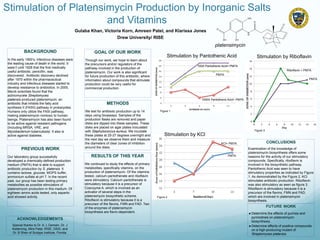
DSSI Poster Final
- 1. Gulaba Khan, Victoria Korn, Amreen Patel, and Klarissa Jones Drew University/ RISE Stimulation of Platensimycin Production by Inorganic Salts and Vitamins BACKGROUND In the early 1900’s, infectious diseases were the leading cause of death in the world. It wasn’t until 1928 that the first medically useful antibiotic, penicillin, was discovered. Antibiotic discovery declined after 1970 within the pharmaceutical industry and infectious diseases started to develop resistance to antibiotics. In 2005, Merck scientists found that the actinomycete Streptomyces platensis produced platensimycin, an antibiotic that inhibits the fatty acid synthesis II (FASII) pathway in prokaryotes. Humans only utilize the FASI pathway, making platensimycin nontoxic to human beings. Platensimycin has also been found to be active against resistant pathogens (including MRSA, VRE, and Mycobacterium tuberculosis). It also is active against diabetes. RESULTS OF THIS YEAR We continued to study the effects of primary metabolites, specifically vitamins, on the production of platensimycin. Of the vitamins tested, calcium pantothenate and riboflavin were stimulatory. Calcium pantothenate is stimulatory because it is a precursor of Coenzyme A, which is involved as an activator of several steps in the platensimycin biosynthetic scheme. Riboflavin is stimulatory because it is a precursor of the flavins, FMN and FAD. Two of the enzymes of platensimycin biosynthesis are flavin-dependent. PREVIOUS WORK Our laboratory group successfully developed a chemically-defined production medium (PM7A) that is able to support antibiotic production by S. platensis. It contains lactose, glucose, MOPS buffer, ammonium sulfate at pH 7. In the recent past, our group has been testing primary metabolites as possible stimulators of platensimycin production in this medium. Of eighteen amino acids tested, only aspartic acid showed activity. METHODS We test for antibiotic production up to 14 days using bioassays. Samples of the production flasks are removed and paper disks are dipped into these samples. These disks are placed on agar plates inoculated with Staphylococcus aureus. We incubate these plates at 25-27 degrees overnight and the next day we observe them and measure the diameters of clear zones of inhibition around the disks. CONCLUSIONS Examination of the knowledge of platensimycin biosynthesis offers some reasons for the activity of our stimulatory compounds. Specifically, riboflavin is involved in the biosynthetic pathway. Pantothenic Acid was seen to have stimulatory properties as indicated by Figure 1. As demonstrated by the Figure 2, KCl stimulates antibiotic production. Riboflavin was also stimulatory as seen as figure 3. Riboflavin is stimulatory because it is a precursor of the flavins, FMN and FAD, which are involved in platensimycin biosynthesis. ACKNOWLEDGEMENTS Special thanks to Dr. A. L Demain, Dr. J Kettenring, Mira Patel, RISE, DSSI, and Dr. B Shen of Scripps Institute, Florida. platensimycin GOAL OF OUR WORK Through our work, we hope to learn about the precursors and/or regulators of the pathway involved in the production of platensimycin. Our work is also significant for future production of this antibiotic, where information about compounds that stimulate production could be very useful for commercial production. FUTURE WORK ● Determine the effects of purines and pyrimidines on platensimycin biosynthesis. ● Determine effects of positive compounds on a high-producing mutant of Streptomyces platensis. Stimulation by Pantothenic Acid PM7A 100X Pantothenic Acid+ PM7A 1000X Pantothenic Acid+ PM7A Stimulation by KCl KCl+ PM7A PM7A Stimulation by Riboflavin Riboflavin + PM7A PM7A Figure 1 Figure 3 Figure 2